Synopsis
We have really taken overhead bridges for granted. It creates a controlled space for us as it controls the pathway, the safety and the weather. We tend to think that we are in control of the path we step onto, but are we controlling the path, or is the path controlling us?
Overhead footbridges have been providing convenient and safe pedestrian traffic over dangerous areas like steep terrains, streams, and eventually vehicular traffic. However, some have realised the true intention behind the bridges may be “control”. Overhead footbridges are attractive to developers for their ability to concentrate transit, commerce, and real estate value, as stated in Parallel Cities: The Multilevel Metropolis1. This is very much true for Hong Kong with many bridges connected to commercial areas, public transport stations and housing estates. What may potentially be a characteristic of Hong Kong is turned into a way developers control us. Pushing us on a fast-paced walk to reach a destination, footbridges limit our view of our neighbourhood and limit our exploration in the city2. To prove the hypothesis of overhead bridges controlling us on where to go, I stepped onto different footbridges and found out most bridges connect to shopping malls while people carrying shopping bags and even carts traverse quickly from the mall to another or back home. However, a few anomalies are spotted, where people stop on the bridge and refuse to move quickly.
It is common for smokers to smoke on bridges due to the regulations of prohibiting indoor smoking, on the rare occasion, hawkers display their goods on a blanket on the side of bridges, several bridges are occupied by the homeless waiting for a public housing flat, and on Sundays, groups and groups of domestic helpers gather on the bridges to have fun on their only holiday. These people are not controlled by the bridges, yet they are all restricted from a formal space doing what they want, which leads them onto the bridges. With minimal regulations on footbridges, people are actually free to do what they want, until complaints are filed. Homeless people are forced to move away from the footbridges from residents’ complaints, and domestic helpers are almost forced to leave their comfort zone of the week due to residents’ complaints, while the problem worsens during the COVID-19 pandemic. The Government enforces strict laws on COVID-19 testing and vaccination on domestic helpers forcing them to sacrifice their rest day, while some residents and even lawmakers hope to lock them in their employers’ house everyday, while such strict laws are not enforced on even riskier communities.
The marginalised groups on bridges are often the ones who give these highly controlled bridges their identity and a touch of humanity by attempting to break free of control. Stop our fast-paced travel and think, what are we doing? Where are we going? Try to observe and reflect on the neighbourhood and the slow-paced travelers, and enjoy the city a bit more, however we want and break out of this control.
Bibliography
1Blauvelt, A., Yoos, J., & James, V. (2016). Parallel Cities: The Multilevel Metropolis (WALKER ART CENT). Walker Art Center.
2on.cc東網. (1970, August 22). 市區天橋四通八達 堅方便定堅離地?. https://hk.on.cc/hk/bkn/cnt/news/20160430/bkn-20160430110748975-0430_00822_001.html
一樓一事. (2021, February 17). 天橋,可能係香港城市特色. 立場新聞 Stand News. https://www.thestandnews.com/city/%E5%A4%A9%E6%A9%8B-%E5%8F%AF%E8%83%BD%E4%BF%82%E9%A6%99%E6%B8%AF%E5%9F%8E%E5%B8%82%E7%89%B9%E8%89%B2/
Wainwright, O. (2020, September 23). Cities Without Ground: a guidebook to Hong Kong’s elevated walkways. The Guardian. https://www.theguardian.com/artanddesign/architecture-design-blog/2013/feb/22/cities-without-ground-hong-kong-walkways
Moss, E. (2020, February 3). “That one day is all you have”: how Hong Kong’s domestic workers seized Sunday. The Guardian. https://www.theguardian.com/cities/2017/mar/10/sunday-sit-in-inside-hong-kong-weekly-domestic-worker-resistance
Highways Department. (2020, June). Footbridges and Subways of Hong Kong. https://www.hyd.gov.hk/en/publications_and_publicity/publications/hyd_factsheets/doc/e_Footbridges_and_Subways.pdf
Kao, S. (2019, February 4). Homeless in Hong Kong: Life on a footbridge. South China Morning Post. https://www.scmp.com/video/hong-kong/2175187/homeless-hong-kong-life-footbridge
Ho, K. (2020, December 29). Covid-19: Lock down domestic workers on their day off, says pro-Beijing Hong Kong lawmaker. Hong Kong Free Press HKFP. https://hongkongfp.com/2020/12/29/covid-19-lock-down-domestic-workers-on-their-day-off-says-pro-beijing-hong-kong-lawmaker/
Hong Kong Free Press. (2021, May 3). ‘Test Hong Kong gov’t for racism’ says migrant coalition, as mass Covid testing of domestic workers yet to yield cases. Hong Kong Free Press HKFP. https://hongkongfp.com/2021/05/03/test-hong-kong-govt-for-racism-says-migrant-coalition-as-mass-covid-testing-of-domestic-workers-yet-to-yield-cases/
Research on Overhead Bridges
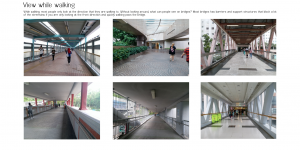
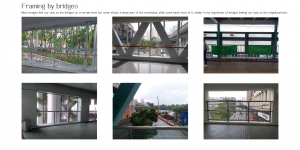
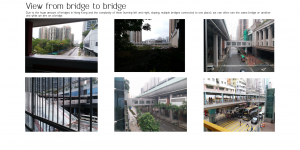
Storyboard and Planning on Filming
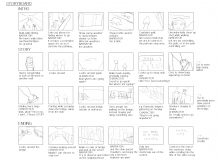


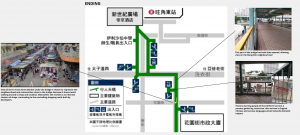
– Liu Hoi Ching (3035820291)
Appreciate your rigorous research – both newspaper and fieldwork. You have also identified one of the key issues of footbridges – whether they control how users use the space, and unveiled the intentions of developers. You have also provided another point of view, talking about how people who are marginalized in other settings are able to exploit and take control of the footbridges. I wonder how you (I suppose you do not see yourself as one of the marginalized in the video) would gain control of the infrastructure? I am sure it would be even more inspiring and creative. Also, using a stabilizer would allow a better viewing experience as you have quite a lot of ‘walking’ scenes.